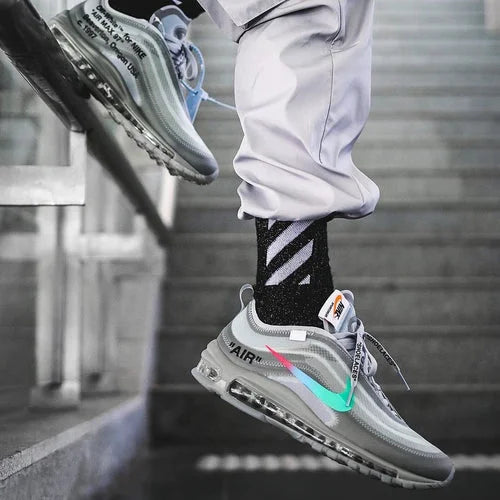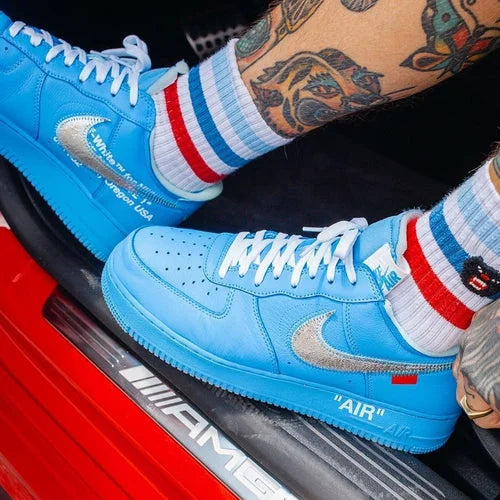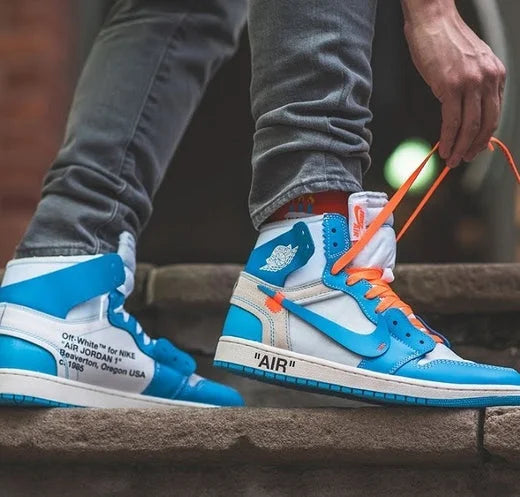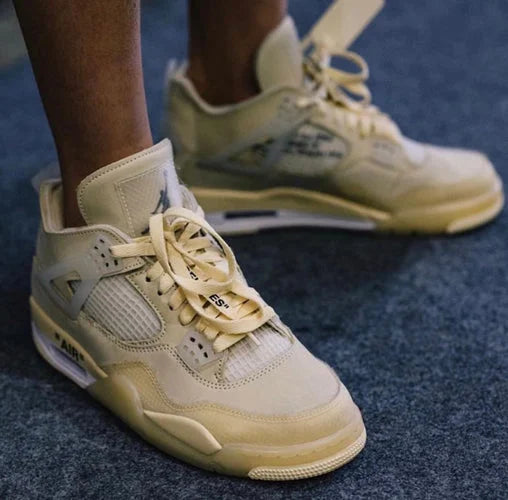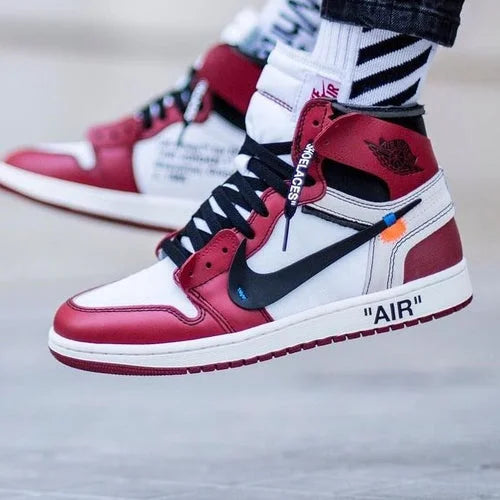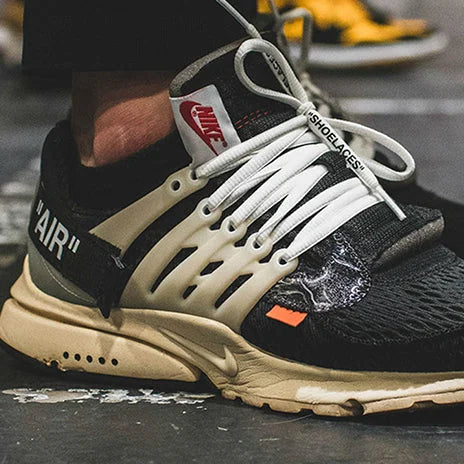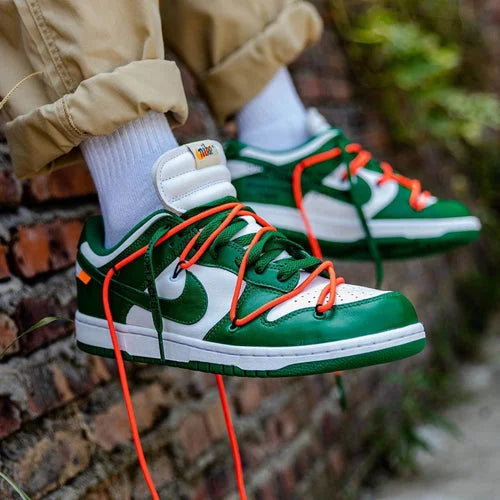How To Spot Real Vs Fake Off-White

Have you ever wondered how to spot fake Off-White items?
Whether you're eyeing a T-shirt, hoodie, or any other piece from the brand, distinguishing real from counterfeit products can be challenging.
This guide will walk you through the process of authenticating Off-White items, ensuring you make informed purchases and avoid falling victim to counterfeit scams.
Table of Contents
- Initial Steps for Verifying Off-White Authenticity
- Packaging Details to Look For
- Detailed Authentication Methods
- The Front Print Technique
- Neck Tag Verification
- Wash Tag Inspection
- The Hangtag Method
- Advanced Tips for Off-White Authentication
- Use of Color and Typography
- Leveraging Expert Authentication Services
- Conclusion
Initial Steps for Verifying Off-White Authenticity
When examining Off-White items, the packaging can provide valuable clues about their authenticity.
Genuine Off-White products typically come with high-quality packaging that includes specific details and features.
Understanding these characteristics can help you differentiate between real and fake items right from the start.
Packaging Details to Look For
Authentic Off-White packaging often features meticulous attention to detail, including precise printing, vibrant colors, and consistent branding.
Pay close attention to the box or bag the item comes in and any accompanying tags or labels. Look for any discrepancies or irregularities that may indicate a counterfeit product.
Detailed Authentication Methods
For a more thorough authentication process, examining specific details of the Off-White item itself is essential. Here are some key authentication methods to help you determine whether a piece is genuine or fake.
The Front Print Technique
One of the most common features of Off-White apparel is the distinctive front print. Authentic Off-White T-shirts, hoodies, and other items often feature intricate designs with precise printing techniques.
Inspect the front print closely for sharp lines, clear details, and consistent coloring. Any blurriness or smudging may indicate a counterfeit item.
Neck Tag Verification
The neg tag verification is one of the most complex details you should look for. Here are all the details you will need.
Neck Label (“MAIN LABEL”)
If your Off-White item is from the Fall-Winter '16 collection or later, it should have the specific neck tags we'll talk about here.
If you're not sure which season your piece is from, don't worry. We'll explain all the Off-White collections later in this guide, and you can easily skip to those sections using the navigation bar.
In the Fall-Winter '16 collection, they introduced green Off-White labels, which you'll find on many genuine items released after that season. However, keep in mind that some pieces from the FW16 collection might still have older tags.
Green “MAIN LABEL” tag (after FW16)
You can tell fake Off-White "MAIN LABEL" tags by touching them. Real Off-White items have raised letters you can feel, while fake ones have flat, printed letters.
Genuine Off-White tees, hoodies, etc., should have text on labels made of a rubbery material that shines when light hits it. The letters should be raised so you can feel them when you run your finger over them. Fake Off-White items often have flat, printed letters on the green label, which don't shine or feel raised.
When checking the stitching on the neck labels, real Off-White tags should have neat stitching with no extra threads or loose stitches. Fake ones may have poor stitching quality, with thin threads, too much stitching, and incorrect printing thickness.
Look at the printing quality, checking for inconsistencies like extra spacing or wrong font on fake Off-White tags. Real Off-White items have high-quality printing with consistent spacing and font usage, while fakes often have mistakes like uneven spacing or different fonts.
Counterfeit Off-White items might have stitching flaws, wrong font, and low-quality printing on their neck tags, making them easy to spot compared to real ones. Real Off-White labels should have neat stitching, the right font, and good printing, showing the brand's high standards.
Off-White's brand image extends to its tags, which should have well-printed text with consistent spacing and font. Fake tags often have noticeable flaws in printing, stitching, and material, making them easy to spot compared to real Off-White tags.
Although some fake Off-White pieces may have accurate stitching, they often lack good printing quality, with mistakes in font and text alignment. When checking the text on the green label, look for inconsistencies like unusual spacing or different fonts from real Off-White labels.
Real Off-White main labels should have neat stitching, the right font, and high-quality printing, while fake labels may have stitching mistakes, wrong font, and bad printing. No matter how good the replica is, finding these mistakes can help tell real from fake Off-White items.
Grey “MAIN LABEL” tag (after FW20)

After FW20, fake Off-White items have noticeable flaws in their grey "MAIN LABEL" tag. The text looks too thick in three areas, making it appear bulky.
Additionally, the quotation marks are too thin, making them hard to see clearly. There's also a typo in the last line, with "whiteas" instead of "white as," and inconsistent letter sizing, like a larger "a" and a smaller "d."
Authentic Off-White items after FW20 have thinner text on the neck tag, making it clearer and more legible.
New Off-White Logo Tag (after SS20)

The fake one has thinner text and graphics, especially noticeable in details like the palm and face illustrations. In contrast, the genuine Off-White item boasts bolder and more substantial text and graphics, showing higher quality.
Additionally, the "LG-425" print on the fake piece is smaller and thinner compared to the authentic one, lacking the boldness and clarity found in genuine items.
Another difference is in the positioning of the words "Main" and "Label." On the fake item, "Main" sits too high above the double-lined blue border, and the "L" in "Label" appears lower than the other letters.
Moreover, the stitching on the fake item uses blue threads instead of the correct white stitches seen on authentic Off-White items, indicating a difference in craftsmanship.
Older Off-White neck tags
Most of you will skip this area. We’re going to analyze older fake Off-White pieces.
After FW16 — “Cut Off” Collection
Keep in mind, the "Off-White" text is always paired with the ™ "Trademark" symbol, never the Registered symbol (®).
Additionally, FW16 products should have the authentic tag displayed below (top pic):
These products should also come with the zip tie taken through the loophole next to the neck tag, as shown below. It's worth mentioning that sometimes there's a secondary tag saying "℅ Virgil Abloh." This is another sign of authenticity, though not all items come with it.
FW16 consisted of a mix of these two types linked above. Now let's proceed to even older OW pieces.
Before FW16 — Older neck tags
Before FW16, older authentic Off-White neck tags had different designs. SS16 and FW15 featured slim Off-White text, while SS15 and FW14 had fat text.
If the tags resemble the ones pictured below, don't worry. This is how the labels may appear after being worn and washed multiple times. However, it doesn't necessarily indicate whether the item is fake or authentic.
Some flaws were observed in these older models, including sloppy craftsmanship, stitching coming undone, indefinite lines, and inconsistent shape. Additionally, black stitching is a red flag for fake older Off-White neck tags.
Wash Tag Inspection

The wash tag test is a helpful way to tell if your Off-White item is real or fake. We'll start by checking the material of the wash tag on counterfeit items, then look at where the item was made, and we'll also show you a map of all the different Off-White collections.
When it comes to material, it's essential to feel the wash tag. Real Off-White tags are usually made of smooth, high-quality fabric. Fake ones might feel rough, shiny, or like thick paper. It can be hard to explain how it should feel, but if you look closely at pictures, you can see the difference.
Another thing to look at is the stitching on the wash tag. Real Off-White tags have neat, dense stitching, while fake ones might have loose threads or messy stitching.
Check where the item was made. Off-White products are usually made in Portugal, Italy, or sometimes Romania. If the wash tag says anything else, like "Made in China" or "Made in Vietnam," it's probably fake.
Before FW16, the wash tag should say "MADE IN UE." After FW16, it depends on the type of item. For example, hoodies and tees are usually made in Portugal, while denim and belts are made in Italy. If the wash tag doesn't match the right country for the item, it's likely fake.
You can also tell when the item is from by looking at the text at the bottom of the wash tag. For example, if it says "CUT OFF" or "SEEING THINGS," it's from a post-FW16 collection. This can help you make sure your Off-White item is the real deal.
The Hangtag Method

When checking the number of lines on the hang tag (before FW20), remember that genuine Off-White hang tags should always have 10 lines on the transparent badge. If you see only 9 lines, it's likely a fake. This small mistake is a common sign of counterfeit items.
The fake rectangle looks too wide and too short. This means the fake item has an incorrectly sized empty rectangle.
On the other hand, the real item also has an empty rectangle, but it's shorter in height and wider in width compared to the fake one.
In short, the genuine hang tag has a taller and narrower empty rectangle, which helps tell it apart from the fake tag.
Advanced Tips for Off-White Authentication
In addition to examining specific details of the item itself, consider broader factors such as material and construction quality.
Authentic Off-White items are known for their premium fabrics and meticulous craftsmanship. Inspect the stitching, seams, and overall construction of the item for any signs of poor quality or sloppy workmanship.
Use of Color and Typography
Color accuracy and typography play a crucial role in authenticating Off-White items.
Genuine Off-White products feature precise color matching and typography that reflects the brand's distinct aesthetic.
Compare the colors and fonts used on the item to known authentic examples to identify any discrepancies.
Leveraging Expert Authentication Services
If you're still unsure about the authenticity of an Off-White item, consider seeking professional authentication services.
Several reputable companies specialize in authenticating luxury fashion items, including Off-White products.
While these services may come with a fee, they can provide valuable peace of mind and assurance of authenticity.
Conclusion
In conclusion, authenticating Off-White items requires careful observation, attention to detail, and knowledge of key authentication methods.
By examining packaging details, scrutinizing specific features of the item, and considering broader factors, you can identify genuine Off-Whites.
Remember to invest in authentic Off-White items to ensure quality and value retention in your wardrobe.
